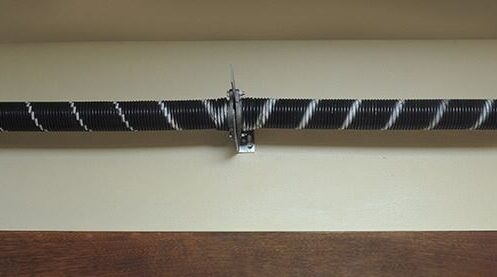What Happens If a Garage Door Spring Breaks?
Garage spring broke? The first step in understanding how to fix it is understanding how it happened in the first place. When the incredible energy bound up in a heavy steel torsion bar reaches the inevitable limit of its materials, it fails – dramatically.
Sometimes with a startling cracking sound, your garage door spring loses its ability to function – totally, and more quickly than you can snap your fingers. At this point, there is only one option: replace the broken spring.
Most standard garage doors come with two springs; it is, as you probably realize, more efficient and cost-effective to replace both garage door springs at the same time, assuming they are the same age and bearing the same number of cycles (openings and closings).
A high-quality spring will be rated at 10,000 cycles. There are signs of metal fatigue to watch for as well – a spring that sags or has a “relaxed” length much over 25 inches, is losing its tensile strength and may be close to failure.
The remaining question is simple but serious. Who is going to do it? Yourself, as a DIY (do-it-yourself) project, or an experienced, properly trained and equipped specialist?
Since you’re reading this on our website, you’re probably expecting us to point emphatically to the second choice – use a pro. Well, you’re right. We do, and you should. But the reasons may need a little clarification, and the explanation made a little more fully, and that’s why we are posting this blog.
How to Tell If There Is a Broken Spring on the Garage Door?
Despite the “all-at-once” failure described above, many times a broken spring will go unnoticed until you next go to open the garage door. The first major clue, and one that should never be ignored:
The opener will struggle mightily, and the door will rise slowly and haltingly, perhaps grindingly. In a word, it will feel “heavy”. Even if only one of the two springs is broken, the difference will be unmistakable. A garage door, especially a glass or wood door, might weigh several hundred pounds, and losing the torque in the steel springs puts the whole system at stress levels beyond its designed capacity.
How Do I Open a Garage Door with a Broken Spring?
If the spring is broken, then it’s best to leave your garage door closed. However, if you need to open your garage door, make sure you do it manually. You should:
- Get help. Garage doors can be extremely heavy, and a second person will both help get it open faster, as well as protect you from injuries.
- Disengage the door from the garage door opener. There should be a handle on a rope connected to the opener. Pull on it to disengage the mechanism.
- Be extremely careful opening the door. Treat it like lifting any other heavy object – don’t lift with your back, watch your fingers, and don’t drop it on your feet.
- Carefully lift the door until it settles in place on the horizontal rails.
It’s extremely important to note that you should never, ever use your opener to open your garage door if the spring is broken. This can lead to serious problems, including:
- Causing the door panels to crack or crumble
- Bend the rails
- Strip gears in your garage door opener
- Break off parts of the opener carriage
- Strip gears in the opener
- In the most serious situations, the opener might be ripped off its mounts entirely
When a garage door spring breaks, NEVER disengage the opener from the door while the door is open. There are circumstances when you may well need to disengage them, such as during a power failure. This is usually accomplished by pulling the red emergency release handle hanging from the track.
But in this situation, when the spring has snapped, it is inviting serious damage to your garage door or other property in its pathway, and injury (or worse) to you or someone who might be standing too close. When the door is released and nothing is holding it up (which is one of the functions of the spring) the door will come crashing down, with its nearly full weight in free fall.
We are not exaggerating the risks in this scenario. While you should never close the door by releasing the red release handle, you can’t leave the door standing open, either. Why not?
Aside from the obvious security risks posed by an open door, someone might try to close the door without realizing the consequences, either by attempting to use the automatic door opener or the emergency release handle. Further, the remaining spring may suddenly fail, and the door will crash on its own.
Until proper repairs and replacements can be done, it’s best to block the door track – on both sides – so the door is relatively stable, like a car lifted on a jack. To avoid any unintended use of the garage door opener, unplug it from the wall. If you feel you must, you can cautiously attempt closing the door with the automatic opener, but make sure there’s nothing in its path, as it may put a strain on the opener beyond its capacity, with unintended consequences.
If you feel especially lucky or desperate, you can have a couple of strong-backed helpers hold the door in place while you disengage the opener (you will recall we advised you to never do this) and carefully lower the door to the ground by muscle power alone. It will be heavy, so watch all fingers and toes. Or, call us at 858-544-5757 for quick service.
Types of Garage Door Springs: Torsion Vs. Extension
Simply defined, there are two kinds of garage door springs: torsion and extension.
The more common torsion springs are heavy-gauge springs mounted on a heavy metal rod. These are mounted parallel to the door roughly a foot or so above the top of the door on the inside wall. These springs are “loaded” (torqued to the right tension level for the spring, as set by the manufacturer) with a set of special, long-handled tools. As the door closes, cables connected at the bottom corners of the door draw on pulleys attached to the ends of the rod/spring assembly. As the pulleys rotate the rod, they twist the springs, creating tension (much like in the spring of a mousetrap). As the door is opened, the springs incrementally stretch out to more than twice their tightly coiled resting state, providing lift.
Extension springs are less commonly used and present their challenges. Essentially long, lighter-weight springs that run parallel to the two-door tracks, guide an automated sectional door up and along the tracks. Extension springs are tensioned by stretching, via cables and pulleys, with the same basic physics as a torsion spring. A key difference: extension springs are suspended between two relatively light brackets, rather than mounted to a securely bolted rod. To help contain the spring in case it breaks, a safety cable is threaded through the spring’s center. Without this feature, you face a serious safety hazard.
While a torsion spring is potentially dangerous until it is fully unwound, an extension spring has little or no tension when the garage door is fully open. Some older extension spring models don’t include cables; these should be installed whether or not the springs need replacing. If the springs are old enough to lack cables, they are likely old enough to warrant replacing the entire assembly.
Should You Hire a Professional to Replace the Garage Door Spring Replacement?
We’ll cut to the chase – working with big, heavy-duty steel springs (not to mention big, heavy-duty doors) is unavoidably dangerous, even for well-trained professionals with pro-quality tools, who do this task week in and week out. The ADS Automatic Door Specialists‘ clear recommendation: call us at 858-544-5757 for an inspection and estimate.
Yes, you can buy the springs and the tools needed for assembly, and you may save some money over a professional installation by doing so. ADS Automatic Door Specialists will not sell the torsion springs to be installed by the homeowner due to liability. If you are confident in your basic mechanical/home improvement skills, and like challenges like this, it’s your call to make. Just remember, though, while the steps are straightforward, they must be done very carefully and in the right order.
You must first safely remove the broken or outdated springs and then install the new ones (perhaps a little like defusing a bomb, and then wiring and setting up a new one). Fortunately, there are well-made instruction videos, including some posted on the internet. And there is always the satisfaction of accomplishing a tough job on your own.
Other things to weigh before you decide: The springs themselves must be properly matched to the garage door and door opener you have. Perfectly installing the wrong spring won’t do you any good. If the opener’s motor was unduly stressed as a result of the spring breakage, it should be inspected and tested.
The tracks, pulleys, and weight-bearing hardware will also need to be inspected, or you may find yourself facing further repairs or replacements. If the door did “crash”, or even dropped heavily or unevenly, it may be out of alignment or damaged in ways that can cause long-term problems.
ADS Automatic Door Specialists believes that providing peace-of-mind service to our customers, with honest, clear answers to their questions, is the best business practice. We’ve built our business one customer and one job at a time. “Defusing” and removing broken springs, properly installing and calibrating the correctly specified new springs, and inspecting all the affected parts of your garage door system with a thorough knowledge of what to look for, is precisely what many hundreds of customers have depended on us for.
If you’re experiencing garage door spring problems in the San Diego area, give ADS Automatic Door Specialists a call at 858-544-5757 and we’ll be glad to answer your questions.


